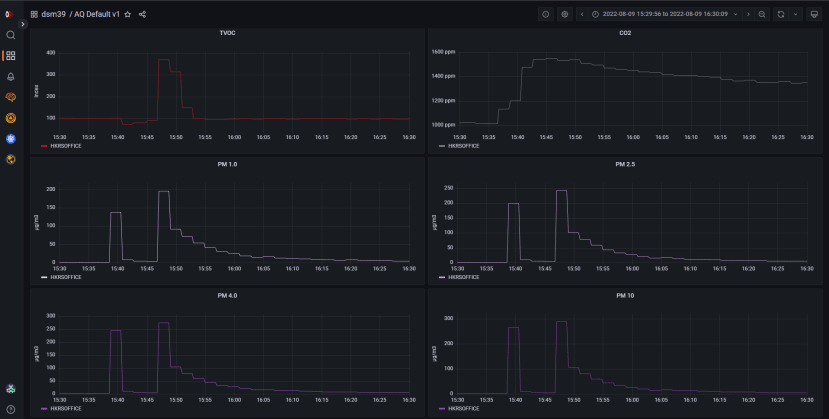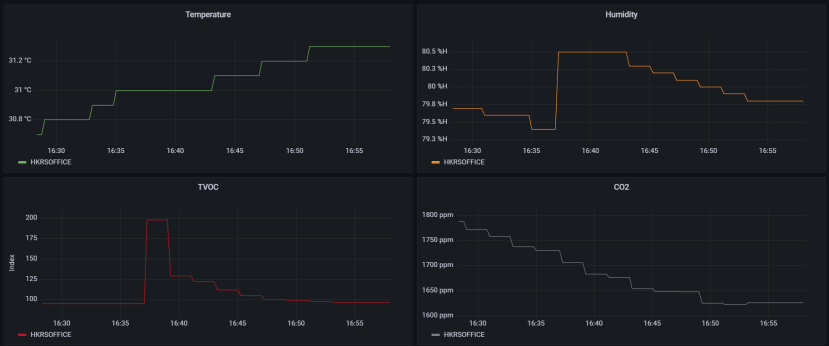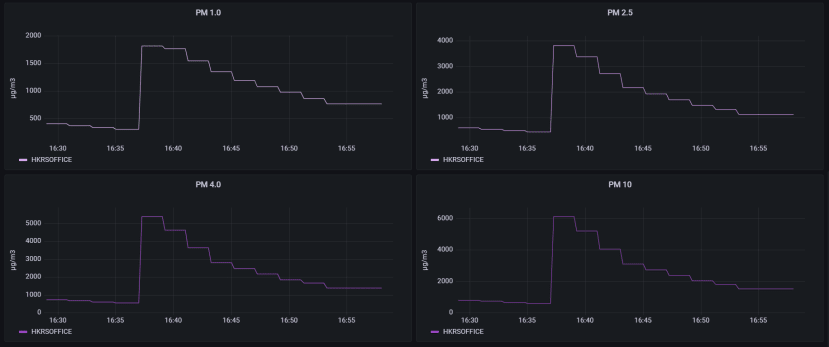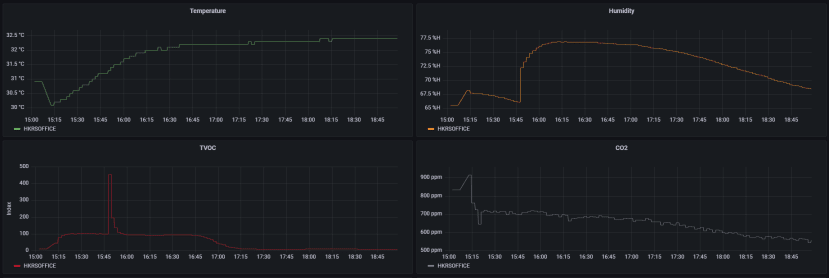Can all cleaners be atomized?
Follow articleHow do you feel about this article? Help us to provide better content for you.
Thank you! Your feedback has been received.
There was a problem submitting your feedback, please try again later.
What do you think of this article?
Under COVID-19, people try their best to disinfect. Many tools appeared in the market for disinfection. In Hong Kong, atomizing spray guns are one of the most common in the market. Most of them are also marked as blue light nano spray, which advertises large fog volume, fine atomization, a long-range, and a wide range of uses. However, can any cleaners be used with the atomizing spray gun? In this project, I will figure out how the air quality changes after using an atomizing spray gun.
I tried experimenting with the most common cleaners to see how air quality changes, which included alcohol, 1:99 diluted household bleach, and chloroxylenol.
First of all, to figure out the effect of atomizing spray guns on changes in air quality. I made a box to simulate a sealed space for measurements.
Then, I add different cleaners to the atomizing spray gun and turn it on for 10 seconds.
Next, monitor changes in the air quality kit readings. Below are the results.
Alcohol
|
Normal |
Peak |
Difference |
Peak to normal time |
|
|---|---|---|---|---|
|
TVOC |
100 |
373 |
273 |
15:47:00 - 15:55:00 |
|
PM1.0 |
4 |
196 |
192 |
15:47:00 - 16:09:30 |
|
PM2.5 |
4 |
244 |
240 |
15:47:00 - 16:09:30 |
|
PM4.0 |
5 |
275 |
270 |
15:47:00 - 16:09:30 |
|
PM10 |
5 |
289 |
284 |
15:47:00 - 16:09:30 |
1:99 diluted household bleach
|
Normal |
Peak |
Difference |
Peak to normal time |
|
|---|---|---|---|---|
|
TVOC |
95 |
198 |
103 |
16:37:45 - 16:53:00 |
|
PM1.0 |
316 |
1814 |
1498 |
- |
|
PM2.5 |
460 |
3825 |
3365 |
- |
|
PM4.0 |
564 |
5406 |
4842 |
- |
|
PM10 |
612 |
6141 |
5529 |
- |
Chloroxylenol
|
Normal |
Peak |
Difference |
Peak to normal time |
Time needed |
|
|---|---|---|---|---|---|
|
TVOC |
100 |
454 |
354 |
15:47:45 - 16:00:00 |
12 mins. 15 sec. |
|
PM1.0 |
1 |
1168 |
1167 |
15:47:45 - 18:30:00 |
2 hrs. 42 mins. 15 sec. |
|
PM2.5 |
2 |
3378 |
3376 |
15:47:45 - 18:30:00 |
2 hrs. 42 mins. 15 sec. |
|
PM4.0 |
2 |
5155 |
5153 |
15:47:45 - 18:30:00 |
2 hrs. 42 mins. 15 sec. |
|
PM10 |
2 |
5981 |
5878 |
15:47:45 - 18:30:00 |
2 hrs. 42 mins. 15 sec. |
|
Alcohol |
1:99 diluted household bleach |
Chloroxylenol |
|||||||
|---|---|---|---|---|---|---|---|---|---|
|
Normal |
Peak |
Difference |
Normal |
Peak |
Difference |
Normal |
Peak |
Difference |
|
|
TVOC |
100 |
373 |
273 |
95 |
198 |
103 |
100 |
454 |
354 |
|
PM1.0 |
4 |
196 |
192 |
316 |
1814 |
1498 |
1 |
1168 |
1167 |
|
PM2.5 |
4 |
244 |
240 |
460 |
3825 |
3365 |
2 |
3378 |
3376 |
|
PM4.0 |
5 |
275 |
270 |
564 |
5406 |
4842 |
2 |
5155 |
5153 |
|
PM10 |
5 |
289 |
284 |
612 |
6141 |
5529 |
2 |
5981 |
5878 |
Before we move on to the result, let's take a look at what is TVOC and PM first.
Total volatile organic compounds (TVOC)
According to the "Indoor Air Quality Guidelines for selected Volatile Organic Compounds (VOCs) in the UK" - Total volatile organic compounds (TVOC) is the sum of the concentrations of the identified and unidentified volatile organic compounds, as specified in the Standard. VOCs are widely used in construction and building products (eg paints, varnishes, waxes, solvents), in household consumer products (detergents, cleaning products, air fresheners and personal care products) and are also emitted while using electronic devices such as photocopiers or printers. Health Organisations (eg The World Health Organization, The US Environmental Protection Agency, PHE) have assessed the evidence and listed the health impacts of VOCs, which include irritation of the eyes and respiratory tract, allergies and asthma, central nervous system symptoms, liver and kidney damage, as well as cancer risks.
| Index Category | Index Value | TVOC (ppb) |
|---|---|---|
| Good | 0 - 50 | 0 - 220 |
| Moderate | 51 - 100 | 221 - 560 |
| High | 101 - 150 | 661 - 1430 |
| Very High | 151 - 200 | 1431 - 2200 |
| Very High | 201 - 300 | 2201 - 3300 |
| Very High | 301 - 500 | 3301 - 550 |
By Kaiterra (https://learn.kaiterra.com/en/resources/understanding-tvoc-volatile-organic-compounds)
Particulate matter (PM)
According to the UKGOV - Concentrations of particulate matter (PM10 and PM2.5), particulate matter (PM) is everything in the air that is not a gas and therefore consists of a huge variety of chemical compounds and materials, some of which can be toxic. Due to the small size of many of the particles that form PM some of these toxins may enter the bloodstream and be transported around the body, lodging in the heart, brain, and other organs. Therefore, exposure to PM can result in serious impacts on health, especially in vulnerable groups of people such as the young, elderly, and those with respiratory problems. As a result, particulates are classified according to size.
The Air Quality Standards Regulations 2010 require that concentrations of PM in the UK must not exceed:
- An annual average of 40 µg/m3 for PM10;
- A 24-hour average of 50 µg/m3 more than 35 times in a single year for PM10;
- An annual average of 20 µg/m3 for PM2.5.
In simple words, a high level of TVOC or PM level can result in serious impacts on health.
The above results show that the time needed for alcohol TVOC levels to go from peak levels to normal levels is the fastest (8 mins), followed by Chloroxylenol (12 mins. 15 sec.) and Bleach 1:99 (15 mins. 15 sec.).
We can see that, after we atomization the alcohol, the index increased to 373, which is a very high level. Although the alcohol TVOC levels only needed a short period of time to go from peak levels to normal levels, which definitely is not a suitable cleaner for atomization. For Chloroxylenol, the index of TVOC after it atomized also increased by 354, hence Chloroxylenol also isn’t a suitable cleaner for atomization. Although 1:99 diluted household bleach has a lower TVOC index than the other two because bleach is alkaline and can irritate the respiratory tract and skin cells if inhaled. Hence, diluted household bleach also isn’t a suitable cleaner for atomization. Therefore, we can see that all of the above cleaners are not suitable cleaners to atomized.
At the same time, we can see an interesting finding that PM levels are very low after alcohol atomization. This is because the alcohol is volatile, therefore the PM level of the alcohol is significantly lower than others.
So, when we are choosing the cleaner for atomization, we should carefully choose the ones marked atomization allowed. Then, we can use it more efficiently and safely.










